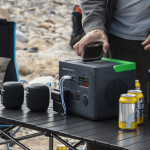Fitness is a field that is continually changing, with new workouts and training methods appearing frequently. The single leg RDL (Romanian Deadlift) using a kettlebell is one exercise that has become more well-liked in recent years. This exercise combines the advantages of the conventional RDL with the added difficulty of unilateral training. In this blog, we will review the single leg RDL with kettlebell in-depth, examining its merits and practical advantages.
Understanding the Single Leg RDL
The conventional Romanian Deadlift is modified by the single leg RDL using a kettlebell. It entails carrying out the exercise while standing on one leg and using the opposing hand to wield a kettlebell. The practice works the core and stabilizer muscles and the posterior chain muscles, including the hamstrings, glutes, and lower back.
How To Perform The Single Leg RDL With Kettlebell
Follow these steps to complete the single leg RDL with a kettlebell:
- Place a kettlebell on the ground before you and take a tall, hip-width position to begin.
- Transfer your weight to your left leg, bending your knee just a little. Throughout the workout, this will be the leg you are standing on.
- Squeeze the handle of the kettlebell with your right hand.
- As you prepare to perform the exercise, engage your core muscles while keeping your spine neutral (avoid rounding or arching your back).
- Hinge at the hips, push your hips back, and stretch your right leg straight behind you to start the activity. From head to heel, your torso and extended leg ought to be in a straight line.
- Lower the kettlebell while hinging forward, maintaining it close to your torso. To keep your balance, you should slightly bend your left knee.
- Lower the kettlebell until your torso is parallel to the ground and you feel a stretch in your hamstrings. Throughout the motion, your back ought to be flat.
- After pausing briefly in the bottom position, resume the exercise by pulling your torso back up to the starting position with the help of your hamstrings and glutes.
- Perform the exercise on one leg for the required repetitions before transferring to the other.
Tips For Proper Form:
– Keep your spine neutral during the activity. Do not allow your back to round or arch.
– To maintain good posture, keep your shoulders pulled back and down.
– To balance your body and safeguard your lower back, contract your core muscles.
– Pay attention to how your hips move as they hinge, pushing them back while maintaining your weight on your heels.
– Don’t twist or rotate while keeping your extended leg aligned with your body.
– As you become more comfortable with the action and maintain perfect form, gradually increase the weight of the kettlebell.
Remember that using appropriate form and technique is more vital than lifting heavy weights. Consider working with a certified fitness professional to ensure you complete the exercise correctly and safely if you have questions about your form or technique.
Functional Benefits of the Single Leg RDL with Kettlebell
Numerous practical advantages of the single leg RDL with a kettlebell can increase your general fitness and performance in various sports. Let’s examine these advantages in more detail:
Improved Balance And Stability
The unilateral exercise known as the single leg RDL with a Kettlebell will test your balance and stability. Training on one leg helps you maintain perfect alignment and control throughout the activity by activating the stabilizer muscles in your hips, ankles, and core. It translates to better balance and stability, which is crucial for motions using only one leg, such as running, jumping, and changing directions.
Enhanced Hamstring And Glute Strength
The hamstrings and glutes are the single leg RDL’s primary focus. These muscles are essential for many functions, such as lifting, running, and walking. You efficiently isolate and engage specific muscle groups during the workout, which increases your strength and power. Athletes with strong hamstrings and glutes perform better, have superior movement mechanics, and experience fewer strains and pulls.
Reduced Muscle Imbalances
Bilateral workouts, which involve using both legs simultaneously, can occasionally conceal muscular deficits or asymmetries. To solve this problem, the single leg RDL with a kettlebell makes each leg work independently. This unilateral training reveals strength or mobility imbalances between your body’s left and right sides. By recognizing and addressing these abnormalities, you can improve overall movement quality, lower your risk of accidents, and increase your functional performance.
Injury Prevention And Rehabilitation
The single leg RDL with a kettlebell can be helpful in healing from injuries and preventing future ones. It improves the stability and support of these joints by building the tendons and muscles around the hips, knees, and ankles. Proprioception, or your body’s capacity to detect its position in space, is another workout benefit. By raising body awareness and encouraging appropriate movement patterns, improved proprioception helps people heal from lower body injuries and stop them from happening in the future.
Core Engagement And Spinal Stability
Keep your spine neutral and stable for the best range of motion and injury avoidance. To maintain the proper alignment of your core muscles, you must exert much effort throughout the single leg RDL with a kettlebell. You can avoid unintentional motions and safeguard your lower back by strengthening and stabilizing your core. A substantial body is necessary for everyday tasks, maintaining excellent posture, and athletic performance.
Functional Carryover To Daily Activities
The single leg RDL with a kettlebell imitates actions frequently seen in everyday life, such as stooping to pick up objects or reaching for things on the ground. By including this exercise in your workouts, you may increase your functional strength and make these movements safer and more injury-resistant. The single leg RDL’s increased strength and stability can improve performance in various activities inside and outside the gym.
In Summary
An excellent exercise for the posterior chain, developing functional strength, and enhancing balance is the single leg RDL with a kettlebell. You can gain advantages such as increased stability, decreased imbalances, greater muscle strength, and injury prevention by including this exercise in your training regimen. Start with modest weights to prevent injury and concentrate on the appropriate form, like any workout. The single leg RDL with a kettlebell is a valuable tool in your toolbox, whether you’re a fitness enthusiast or an athlete trying to increase performance. So, take a kettlebell, work on your balance, and discover the single leg RDL’s functional advantages.









